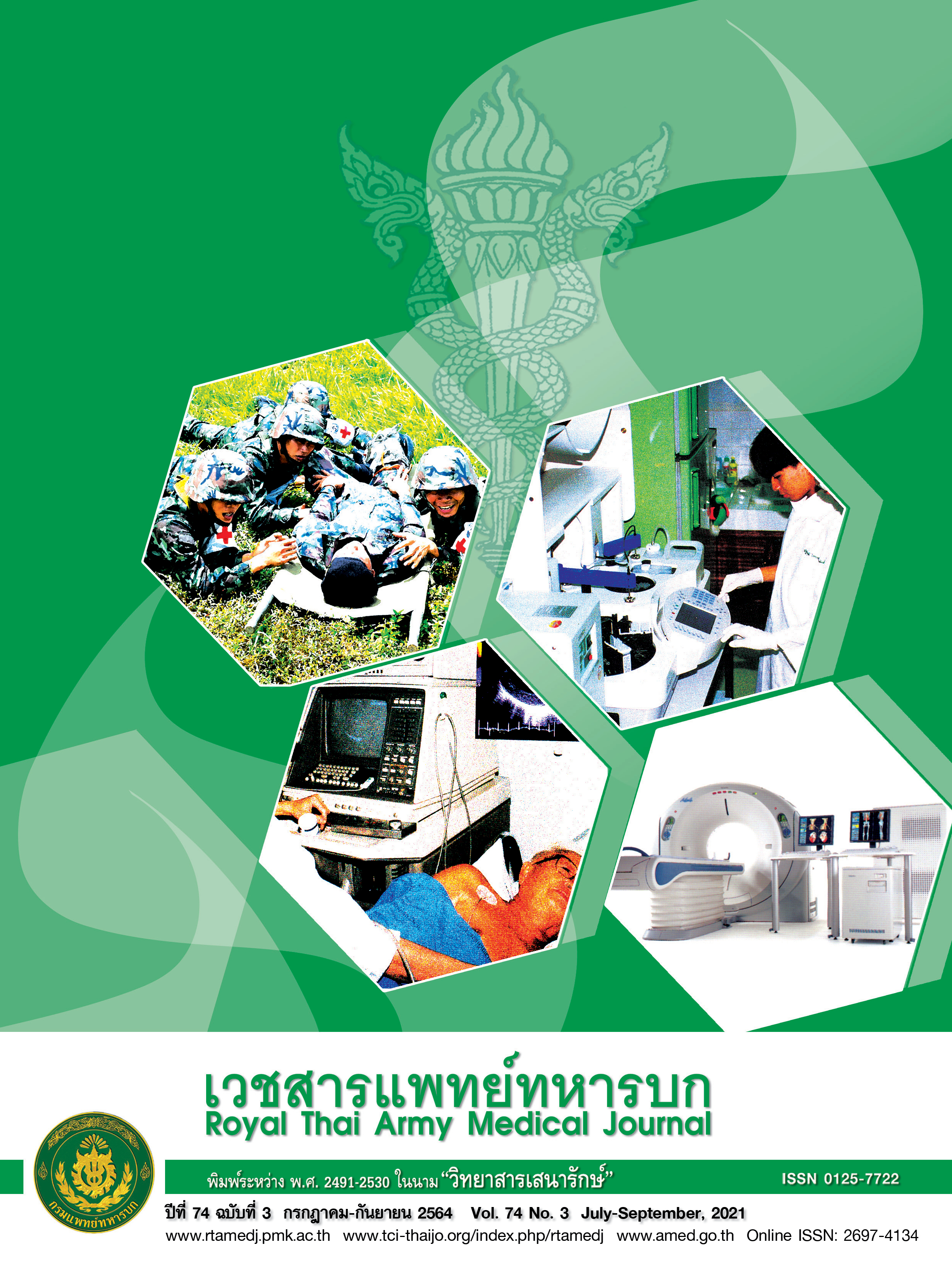รายงานผู้ป่วยกลุ่มอาการ Watery Diarrhea Hypokalemia and Achlorhydria (WDHA) ในเด็กหญิงไทยอายุ 18 เดือน ที่เข้ารับการรักษาด้วยอาการท้องร่วงชนิดขับสารน้ำเรื้อรัง
Main Article Content
บทคัดย่อ
กลุ่มอาการ WDHA คือกลุ่มอาการที่ผู้ป่วยมีอาการท้องร่วง ระดับโปแตสเซียมในเลือดต่ำ และมีภาวะไร้กรดในกระเพาะอาหาร (achlorhydria) กลไกการเกิดภาวะนี้พบว่าเกิดจากการหลั่ง vasoactive-intestinal peptide (VIP) มากเกินปกติ ซึ่งสาเหตุที่พบบ่อยเป็นการหลั่งจากก้อนเนื้องอกที่สร้าง VIP ในผู้ป่วยเด็กพบกลุ่มอาการนี้เป็นสาเหตุของภาวะท้องร่วงเรื้อรังได้น้อยมาก บทความนี้รายงานผู้ป่วยเด็กหญิงอายุ 18 เดือนที่มีอาการท้องร่วงชนิดขับสารน้ำ(secretory) ร่วมกับมีอาการขาดน้ำและเสียสมดุลของเกลือแร่อย่างรุนแรง การตรวจร่างกายพบอาการขาดน้ำที่รุนแรง (severe dehydration) และพบก้อนในช่องท้องด้านบนซ้าย การตรวจทางห้องปฏิบัติการพบ stool osmotic gap แคบ โปแตสเซียมในเลือดต่ำ และความเป็นกรดในเลือด (metabolic acidosis) มากขึ้น นอกจากนี้การตรวจคลื่นเสียงสะท้อนและการตรวจเอกซเรย์คอมพิวเตอร์ของช่องท้องยืนยันการพบก้อนเหนือในช่องท้องด้านซ้ายบริเวณretroperitoneum ผู้ป่วยได้รับการรักษาเบื้องต้นโดยใช้ octreotide และยาเคมีบำบัด แต่ไม่พบการตอบสนองต่อการรักษานี้ หลังจากนั้นจึงพิจารณาการรักษาทางศัลยกรรมเพื่อผ่าตัดนำก้อนเนื้องอกออกในอีก 2 เดือนต่อมา ผลการตรวจชิ้นเนื้อรายงานพบเนื้องอกชนิด ganglioneuroma หลังจากการผ่าตัดพบว่าปริมาณอุจจาระ ภาวะการขาดน้ำและภาวะเสียสมดุลของเกลือแร่ในร่างกายดีขึ้นอย่างชัดเจน ภาวะ WDHA เป็นภาวะที่พบได้ไม่บ่อยในเด็ก การตรวจร่างกายอย่างพิถีพิถันและการตรวจเพิ่มเติมทางรังสีวินิจฉัยมีความสำคัญเพื่อให้ได้การวินิจฉัยอย่างแม่นยำ การรักษาทางศัลยกรรมเพื่อนำก้อนเนื้อออกยังเป็นการรักษาหลักที่ใช้ในภาวะนี้
Downloads
Article Details
บทความในวารสารนี้อยู่ภายใต้ลิขสิทธิ์ของ กรมแพทย์ทหารบก และเผยแพร่ภายใต้สัญญาอนุญาต Creative Commons Attribution-NonCommercial-NoDerivatives 4.0 International (CC BY-NC-ND 4.0)
ท่านสามารถอ่านและใช้งานเพื่อวัตถุประสงค์ทางการศึกษา และทางวิชาการ เช่น การสอน การวิจัย หรือการอ้างอิง โดยต้องให้เครดิตอย่างเหมาะสมแก่ผู้เขียนและวารสาร
ห้ามใช้หรือแก้ไขบทความโดยไม่ได้รับอนุญาต
ข้อความที่ปรากฏในบทความเป็นความคิดเห็นของผู้เขียนเท่านั้น
ผู้เขียนเป็นผู้รับผิดชอบต่อเนื้อหาและความถูกต้องของบทความของตนอย่างเต็มที่
การนำบทความไปเผยแพร่ซ้ำในรูปแบบสาธารณะอื่นใด ต้องได้รับอนุญาตจากวารสาร
เอกสารอ้างอิง
2. Scheibel E, Rechnitzer C, Fahrenkrug J, Hertz H. Vasoactive intestinal polypeptide (VIP) in children with neural crest tumours. Acta Paediatr Scand. 1982;71:721-5.
3. Verner JV, Morrison AB. Islet cells tumor and a syndrome of refractory watery diarrhea and hypokalaemia. Am J Med. 1958;25:374-80.
4. Belei OA, Heredea ER, Boeriu E, Marcovici TM, Cerbu S, Mărginean O, et al. Verner-Morrison syndrome. Literature review. Rom J Morphol Embryol. 2017;58:371-6.
5. Swift PG, Bloom SR, Harris F. Watery diarrhea and ganglioneuroma with secretion of vasoactive intestinal peptide. Arch Dis Child 1975;50:896-9.
6. Petersom HD, Collins OD 3 rd. Chronic diarrhea and failure to thrive secondary to ganglioneuroma. Arch Surg. 1967;6:934-6.
7. Sackel SG, Manson JE, Harawi SJ, Burakoff R. Watery diarrhea syndrome due to an adrenal pheochromocytoma secreting vasoactive intestinal polypeptide. Dig Dis Sci 1985;30:1201-7.
8. Said SI, Faloona GR. Elevated plasma and tissue levels of vasoactive intestinal polypeptide in the watery diarrhea syndrome due to pancreatic bronchogenic and other tumors. N Engl J Med 1975;293:155-60.
9. Iida Y, Nose O, Kai H, Okada A, Mori T, Lee PK, et al. Watery diarrhoea with a vasoactive intestinal peptide-producing ganglioneuroblastoma. Arch Dis Child. 1980;55:929-36.
10. Parbhu SK, Adler DG. Pancreatic neuroendocrine tumors: contemporary diagnosis and management. Hosp Pract (1995). 2016;44:109-19.
11. de Herder WW, Rehfeld JF, Kidd M, Modlin IM. A short history of neuroendocrine tumours and their peptide hormones. Best Pract Res Clin Endocrinol Metab. 2016;30:3-17.
12. Yeh PJ, Chen SH, Lai JY, Lai MW, Chiu CH, Chao HC, et al. Rare Cases of Pediatric Vasoactive Intestinal Peptide Secreting Tumor With Literature Review: A Challenging Etiology of Chronic Diarrhea. Front Pediatr. 2020;8:430.
13. Zhang WQ, Liu JF, Zhao J, Zhao SY, Xue Y. Tumor with watery diarrhoea, hypokalaemia in a 3-year-old girl. Eur J Pediatr. 2009;168:859-62.
14. Funato M, Fujimura M, Shimada S, Takeuchi T, Kozuki K, Iida Y. Rapid changes of serum vasoactive intestinal peptide after removal of ganglioneuroblastoma with watery-diarrhea-hypokalemia-achlorhydria syndrome in a child. J Pediatr Gastroenterol Nutr. 1982;1:131-5.
15. Yamaguchi K, Abe K, Otsubo K, Haniuda C, Suzuki M, Shimada A, et al. The WDHA syndrome: clinical and laboratory data on 28 Japanese cases. Peptides. 1984;5:415-21.
16. Kawahara S, Ueki T, Tsutsumi K, Oda T, Kobayashi S, Fujisawa T, et al. Use of a somatostatin analog to improve a patient's condition and the subsequent diagnosis of pancreatic VIPoma:a case report. Nihon Shokakibyo Gakkai Zasshi. 2020;117:84-91.
17. Várkonyi TT, Velösy B, Nagy I, Németh J, Lonovics J. Verner-Morrison (WDHA) szindróma diagnózisa és kezelése Sandostatin és streptozotocin adagolással [Diagnosis of Verner-Morrison syndrome (VDHA) and its treatment with sandostatin an streptozocitin]. Orv Hetil. 1993;134:2599-602.
18. Decarolis B, Simon T, Krug B, Leuschner I, Vokuhl C, Kaatsch P, et al. Treatment and outcome of Ganglioneuroma and Ganglioneuroblastoma intermixed. BMC Cancer. 2016 Jul 27;16:542.
19. Kogner P. Neuropeptides in neuroblastomas and ganglioneuromas. Progr Brain Res. 1995;104:325-38.
20. Lacey SR, Gribble TJ, Kosloske AM. Favorable prognosis of vasoactive intestinal peptide-secreting ganglioneuroblastoma. Pediatr Surg Int. 1989;4:217-9.


